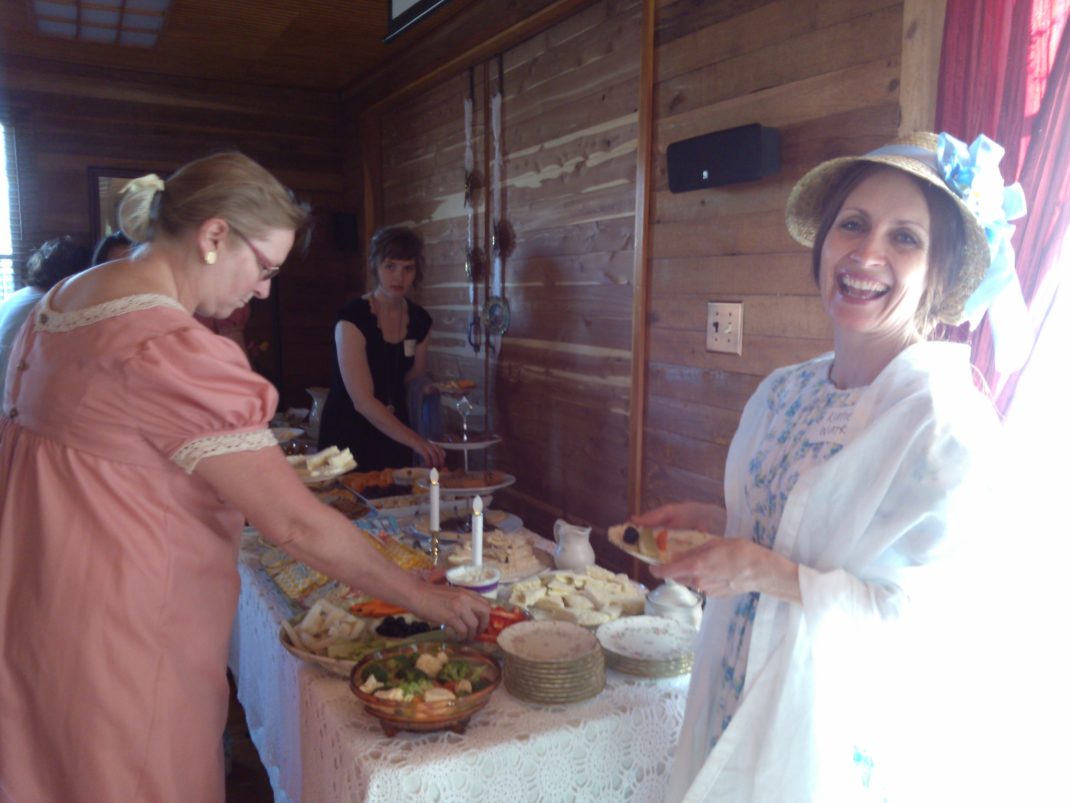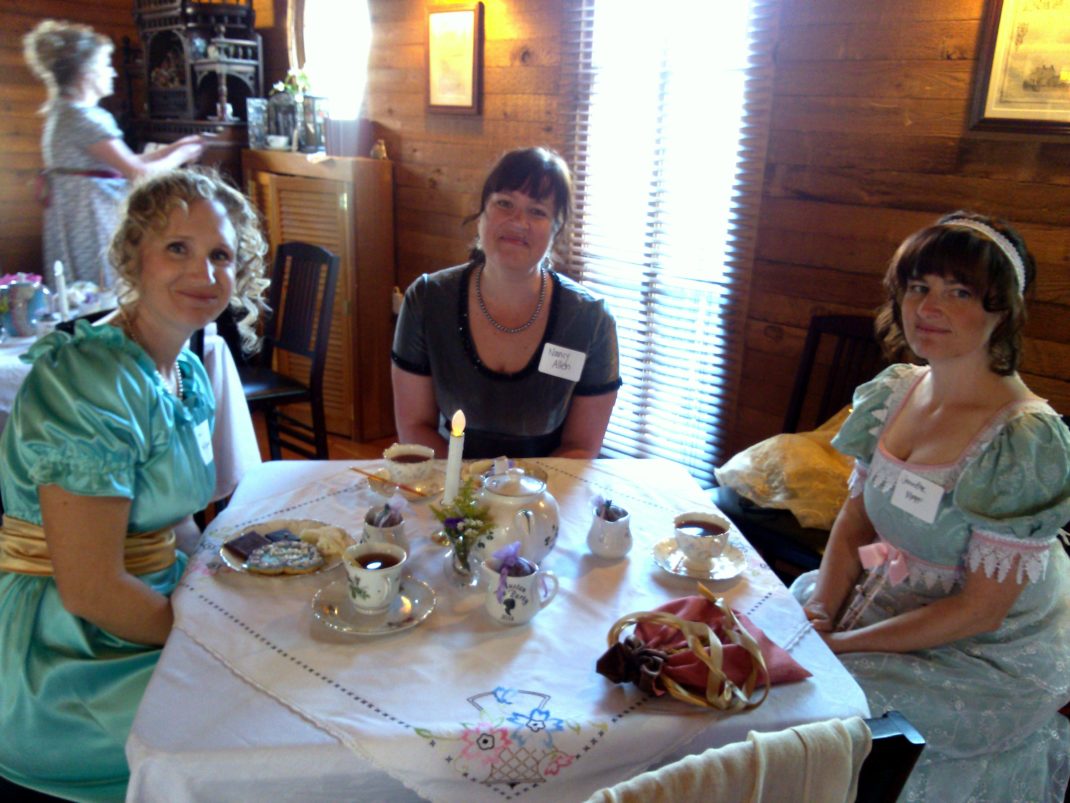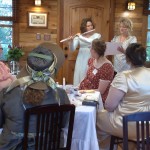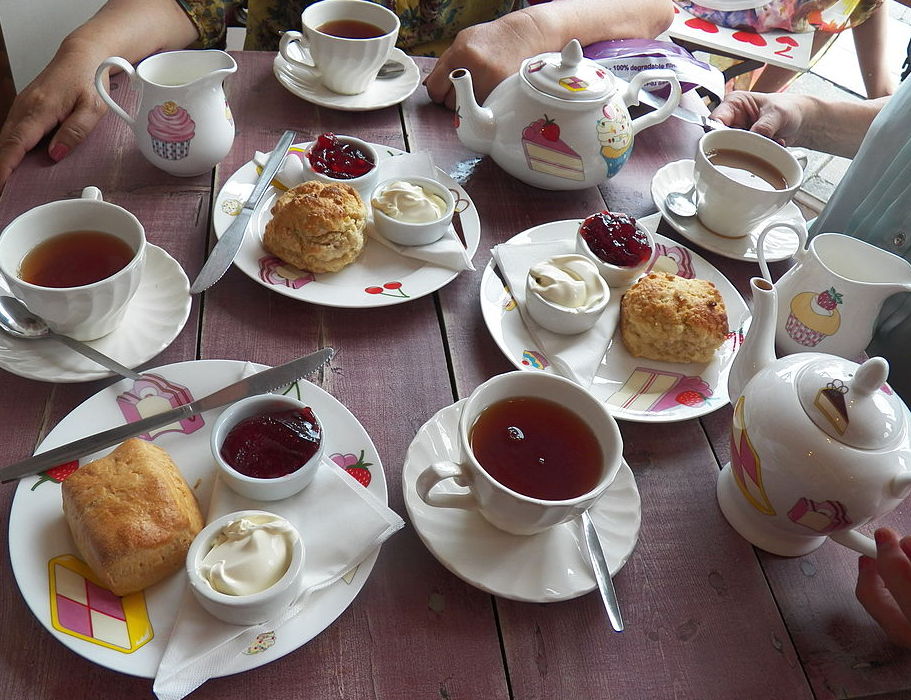Tea is a time-honored tradition, and to me (an American), nothing says British Custom like afternoon tea. While most of us may think of High Tea as an upper class tradition dating back hundreds of years, I discovered something else entirely.
Tea in the afternoon didn’t actually become common until the 1700’s. By the Regency Era, the custom had long-since caught on and the upper class had afternoon tea about four o’clock, which was before the fashionable time to promenade in Hyde Park if one was in London. Afternoon tea included, of course, tea served hot. Also served with tea, one would find small finger sandwiches (thin and crust-less, thank you), biscuits (which the Americans call cookies), seedcake, and small cakes—not petite fours, at least, not during Regency but small cakes sometimes called fairly cakes with butter icing, which, from what I’ve been able to tell, were probably not much bigger than mini cupcakes. There has been much discussion among Regency enthusiasts as to whether scones with jam and clotted cream (also known as Devonshire cream) were served during the Regency or if that become more common during the Victorian era, when High Tea became such a grand affaire.
Food with tea probably evolved because the upper classes ate dinner at the fashionable time of about eight o’clock at night, and since many had not yet adopted the custom of luncheon or nuncheon, they probably needed that small meal in the middle of the day. Personally, I like a small meal in the afternoon even though I do eat lunch. I would have made a great hobbit with with custom of eating “elevensies” and lunch and afternoon tea, etc. But I digress.
“High Tea” developed during the Victorian era. Some accounts say that high tea, served later in the day at about five or six o’clock, originated with the lower classes but I don’t understand how they could come home from work for high tea and then return to work for a few hours and then go home again for dinner. *shrug* Plus, tea was expensive.
At any rate, High Tea is a more filling meal than afternoon tea. High tea usually comes with white and brown bread, meats such as roast pork, fish like salmon, scones, an assortment of sweets such as cake pie, trifle, lemon-cheese tarts, sponge cake, walnut cake, chocolate roll, pound cake, currant teacake, curd tart, macaroons, a variety of cheeses, jellies, as well as butter or clotted cream.
According to Laura Boyl in her article “Tea Time” on the Jane Austen website, the different names are derived from the height of the tables where the meals were served. Low tea is served on a table, which in the United States would be called “coffee tables.” High tea is served on the dinner table.
Because the characters in my Regency romance novels all hail from the upper class, or end up there eventually, I will focus on afternoon tea because that’s what they do every day, unless they are fighting pirates or running for their lives or battling villains, of course.
Most sandwiches in the UK are traditionally made with a very thin white bread, generously buttered with potted paste. The potted paste could similar to deviled ham, but also could be a fish paste–salmon, for instance, very thinly spread. I guess they liked their pleasures small, thin, and bite-sized.
Tea was (and still is, sometimes) served in a china or silver pot accompanied by slices of lemon or milk. They never put cream in their tea or it would ruin the flavor. According to Regency researcher and author, Kathryn Kane, tea leaves used during the Regency were chopped much more coarsely than those used today. The large size required that the tea be steeped for a longer period, but it also made it easier to strain the used leaves from the tea after it had been steeped. There was a special implement included in many tea services used to clear the strainer at the base of the spout of the tea pot, or to strain the used leaves out of each cup before it was served. You can find more detail at: http://regencyredingote.wordpress.com/2013/11/08/the-mote-skimmer-a-specialty-tea-accessory/
 However, Regency author Grace Kone, who is British, told me that if it’s done correctly, the tea leaves stay on the bottom, with just enough pouring out to make a scattering of leaves for fortune-telling. (It sounds very Harry Potter, doesn’t it?) Grace said she has never in her life strained leaf tea. Other British friends such as author Janis Susan May Patterson use something called a tea ball, which is small metal case into which she places the tea leaves. These are also known as ‘tea eggs.’ Other friends pour their tea into their cups through a silver tea strainer, like the one in this picture:
However, Regency author Grace Kone, who is British, told me that if it’s done correctly, the tea leaves stay on the bottom, with just enough pouring out to make a scattering of leaves for fortune-telling. (It sounds very Harry Potter, doesn’t it?) Grace said she has never in her life strained leaf tea. Other British friends such as author Janis Susan May Patterson use something called a tea ball, which is small metal case into which she places the tea leaves. These are also known as ‘tea eggs.’ Other friends pour their tea into their cups through a silver tea strainer, like the one in this picture:Here is a recipe, courtesy Regency author, Miranda Neville, for cucumber sandwiches:
Very thinly sliced white bread (or whole wheat if you insist on being healthy but really, why bother?). I use Pepperidge Farm Very Thin
Good quality unsalted butter
English cucumbers (about† one and a half per loaf of bread)
Salt
1. Slice the cucumbers very thin. Put them in a colander mixed up with some† salt, weigh them down with a plate, and leave them in the sink to drain for an hour or two.
2. Wash the salt off and pat dryish with a dish towel.
3. Butter the bread.
4. Put two layers of cucumber slices in each sandwich and press flat with your hand so it all sticks together, preferably without becoming totally squashed.
5. Cut off the crusts (very important). With a big sharp knife cut each sandwich into four – triangles, squares, or strips, your preference.
And from “The Royal Pavilion at Brighton a booklet A Choice Selection of Regency Recipes you can now make at Home” here is a recipe for macaroons.
Macaroons.
1 large egg white
2 oz ( 55 g) ground almonds
2 oz (55) g caster sugar
a few drops rose water
1-2 drops almond essence
about 12 slivered almonds =-optional.
Heat the oven to 160C/325F/gas3
Line as baking sheet with baking parchment paper. Whisk egg white until stiff. Using a large metal spoon, fold in the ground almonds, sugar, rosewater, and almond essence. Mix until blended into a smooth thick paste.
Using a teaspoon, put blobs of the mixture on the lined baking sheet, leaving space between them to allow for expansion during cooking. Flatten with the back of a spoon. If you like you can top each with a sliver of almond. Bake for about 20 minutes until light golden brown. Transfer to wire rack and leave to cool. Makes about 12.
Sounds yummy, doesn’t it?
 I think for my next book launch I will have afternoon tea. In fact, I may not wait that long. I may just have a tea party just because it’s a fun and sort of a girly thing to do. I’m not a traditional tea drinker because I don’t use a lot of caffeine, so I may deviate from tradition and have herbal tea in my cup. But having tea is great fun. I attend an annual Jane Austen tea in Salt Lake City, UT with some of my Jane Austen geeky friends such as Sarah M. Eden. We have high tea, so we had lots of food (including non-traditional fruit and veggies) and we eat at small dinner tables with chairs. We all dress up and did our fair fancy.
I think for my next book launch I will have afternoon tea. In fact, I may not wait that long. I may just have a tea party just because it’s a fun and sort of a girly thing to do. I’m not a traditional tea drinker because I don’t use a lot of caffeine, so I may deviate from tradition and have herbal tea in my cup. But having tea is great fun. I attend an annual Jane Austen tea in Salt Lake City, UT with some of my Jane Austen geeky friends such as Sarah M. Eden. We have high tea, so we had lots of food (including non-traditional fruit and veggies) and we eat at small dinner tables with chairs. We all dress up and did our fair fancy.
 We even have some period entertainment such as a poetry reading, a soloist, and a flutist. It was so fun!
We even have some period entertainment such as a poetry reading, a soloist, and a flutist. It was so fun!
Have you ever had afternoon tea?


We have a lovely tea room in our area, the Quail and Thistle, that you must visit sometime. We’ve had tea there many a time.
There is also a tea room in San Francisco that we must visit together someday. I think you need to make a tea-run to California to visit your family here!
Who ate macaroons(meaning which class) and at what time or times did people eat them. Also what class had sugar sculptures and when would you see them??
Tea was expensive enough that the working class probably didn’t drink it very often so it stands to reason that they would not have eaten cakes, biscuits, macaroons, etc either as part of a daily tea ritual. I have found mention of ice sculptures but not sugar sculptures, at least, not during the Regency. It doesn’t mean they didn’t have them, but I am not aware of the custom. The French, who were culinary wizards, might have been doing sugar sculptures then. If the English had something so fancy as sugar sculptures, I would assume only the wealthy would have them, and only on formal occasions such as a formal dinner party, ball, houseparty, etc.
I’ve had high tea several times at the Windsor, a Melbourne hotel famous for it. They place a cake stand full of sandwiches, cakes and scones in front of you. It doesn’t look like much, but I rarely have room left for anything from the buffet, even though I share the cake stand with family and friends! And a bottomless cup of tea or coffee.
Thanks for the recipes. So THAT’S what cucumber sandwiches are like! As a former Lady Bracknell, I’ve always wondered. 😉 I make macaroons and have even done them with almonds, but never with rose water! Must try it next time.